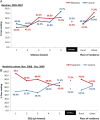Increasing access to care for sick newborns: evidence from the Ghana Newhints cluster-randomised controlled trial
- PMID: 27297006
- PMCID: PMC4916576
- DOI: 10.1136/bmjopen-2015-008107
Increasing access to care for sick newborns: evidence from the Ghana Newhints cluster-randomised controlled trial
Abstract
Objectives: To evaluate the impact of Newhints community-based surveillance volunteer (CBSV) assessments and referrals on access to care for sick newborns and on existing inequities in access.
Design: We evaluated a prospective cohort nested within the Newhints cluster-randomised controlled trial.
Setting: Community-based intervention involving more than 750 000, predominantly rural, population in seven contiguous districts in the Brong-Ahafo Region, Ghana.
Participants: Participants were recently delivered women (from more than 120 000 women under surveillance) and their 16 168 liveborn babies. Qualitative in-depth interviews with referral narratives (IDIs) were conducted with 92 mothers, CBSVs and health facility front-desk and maternity/paediatrics ward staff.
Interventions: Newhints trained and effectively supervised 475 CBSVs (existing within the Ghana Health Service) in 49 of 98 supervisory zones (clusters) to assess and refer newborns with any of the 10-key-danger signs to health facilities within the first week after birth; promote independent care seeking for sick newborns and problem-solve around barriers between November 2008 and December 2009.
Primary outcomes: The main evaluation outcomes were rates of compliance with referrals and independent care seeking for newborn illnesses.
Results: Of 4006 sampled, 2795 (69.8%) recently delivered women received CBSV assessment visits and 279 (10.0%) newborns were referred with danger signs. Compliance with referrals was unprecedentedly high (86.0%) with women in the poorest quintile (Q1) complying better than the least poor (Q5):87.5%(Q1) vs 69.7%(Q5); p=0.038. Three-quarters went to hospitals; 18% were admitted and 58% received outpatient treatment. Some (24%) mothers were turned away at facilities and follow-on IDIs showed that some of these untreated babies subsequently died. Independent care seeking for severe newborn illness increased from 55.4% in control to 77.3% in Newhints zones, especially among Q1 where care seeking almost doubled (95.0% vs 48.6%; RR=1.94 (1.32, 2.84); p=0.001). Rates were the highest among rural residents but urban residents complied quicker.
Conclusions: Home visits are feasible and a potentially pro-poor approach to link sick newborns to facilities. Its effectiveness in improving survival hinges on matched improvement in facility quality of care.
Trial registration number: NCT00623337.
Keywords: EPIDEMIOLOGY; PREVENTIVE MEDICINE; PRIMARY CARE.
Published by the BMJ Publishing Group Limited. For permission to use (where not already granted under a licence) please go to http://www.bmj.com/company/products-services/rights-and-licensing/
Figures





References
-
- Darmstadt GL, Zaidi Anita KM, Stoll B. Neonatal infections: a global perspective. In: Remington JS, Klein JO, Wilson CB, Nizet V, Maldonado Y, eds. Infectious diseases of the fetus and Newborn infant. 7th edn Philadelphia: Saunders, 2011:24.
Publication types
MeSH terms
Associated data
LinkOut - more resources
Full Text Sources
Other Literature Sources
Medical
